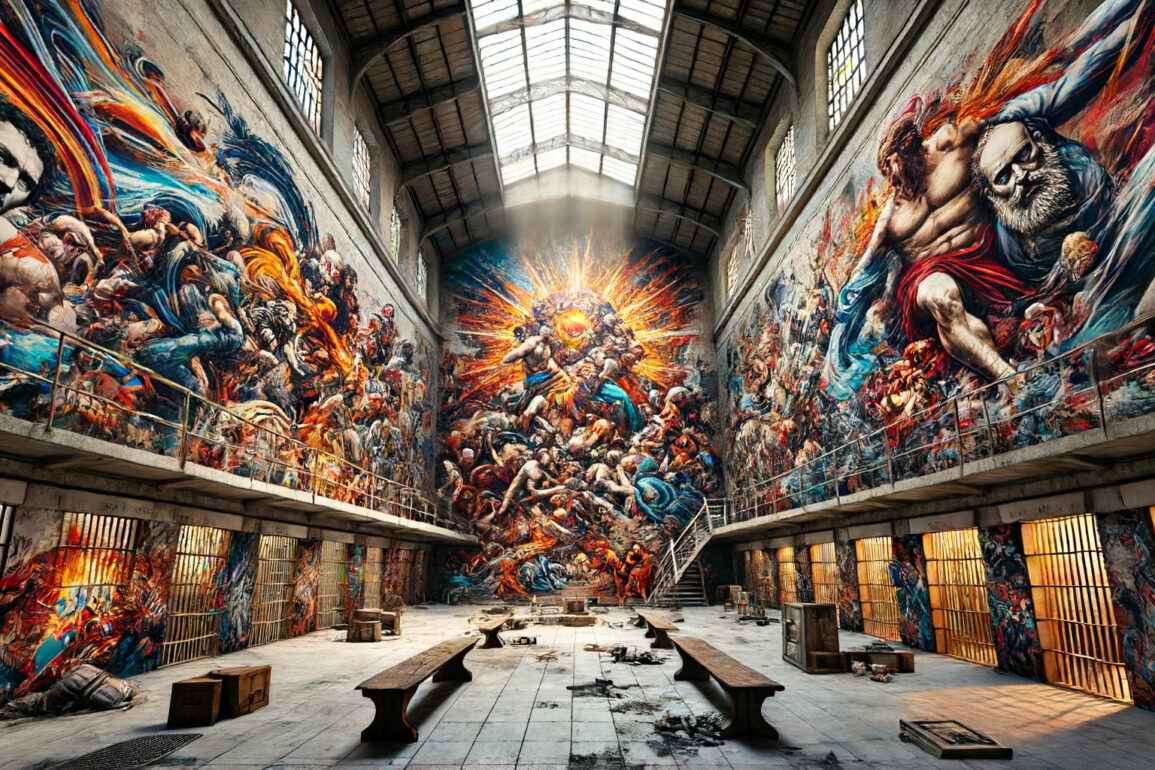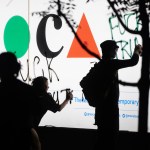In a hail of bullets and brushstrokes, Chamizo and C-Note unleash a rebellious symphony of neo-expressionism and Renaissance revivalism, their prison-born art a Molotov cocktail exploding with firearm-laden masterpieces.
Prison art, a powerful yet often overlooked genre, provides a unique window into the lives and minds of incarcerated individuals. This art form is not only a means of personal expression but also a stark commentary on the societal and personal circumstances surrounding those who create it. Two notable figures in this genre are Didier Chamizo, a French artist who found his voice in the confines of prison, and Donald “C-Note” Hooker, an American artist whose work echoes the systemic injustices and harsh realities of gang life and incarceration.
Didier Chamizo, imprisoned for 17 years, turned to art as a form of liberation and expression, eventually earning acclaim for his dynamic and rebellious works. His art, deeply influenced by the neo-perspective of digital images and contemporary media, often features firearms as potent symbols of his tumultuous past and his fight against societal inequalities. His current exhibition Rebel Soul marks a significant milestone in his artistic journey, highlighting the fusion of his experiences and artistic evolution.
In stark contrast, C-Note, who has been incarcerated for over 27 years, uses his art to address themes of systemic injustice and prison reform. His works often feature firearms derived from his original tattoo patterns intended for gang members, reflecting his deep ties to gang culture and the urban environment that shaped his early life. C-Note’s art stands out for its poignant commentary on the harsh realities of prison life and the broader societal issues that contribute to it.
This article delves into the lives and works of these two prison artists, examining the pervasive theme of firearms in their art, their unique artistic styles, and the social and cultural impacts of their creations. Through a detailed comparison, we aim to uncover the profound connections and differences that define their artistic journeys and the messages they convey from behind bars.
II. Backgrounds of the Artists
Didier Chamizo
Early Life and Rebellious Youth
Didier Chamizo was born in Cahors, France, in 1951. He grew up in a period marked by social upheaval and rebellion, which deeply influenced his worldview. Chamizo’s early years were characterized by a strong connection to the proletarian struggles of the 1960s and 70s. His involvement in libertarian fights and close association with armed groups eventually led to his imprisonment.
Imprisonment and Discovery of Art
During his 17 years in prison, Chamizo discovered painting as a form of escape and self-expression. This transformative experience allowed him to channel his rebellious spirit and critique societal inequalities through his art. He sarcastically titled his first series Freedom, reflecting his complex relationship with the concept.
Release and Current Exhibition “Rebel Soul”
Chamizo was released in 1991 and has since continued to develop his artistic career. His current exhibition, Rebel Soul, held in the UK, marks his first solo show in the country. This exhibition showcases Chamizo’s evolution as an artist and his ongoing exploration of themes related to freedom, rebellion, and societal critique.
Donald “C-Note” Hooker
Orphaned Upbringing and Gang Involvement
Donald Oliver Hooker, better known as C-Note, was born in Los Angeles, California, in 1965. Orphaned at birth, he was adopted by a loving African American couple; however, his parents divorced when he was 13. This change in home life supervision and finances led C-Note into the world of gangs. By his teens, he was deeply involved with the Crips, seeking the material gains and sense of belonging that gang life seemed to offer.
Long-term Incarceration and Shift to Visual Art
C-Note has been incarcerated for over 27 years. His journey in art began as a means to communicate his experiences and frustrations. Influenced by his surroundings and personal history, C-Note’s art addresses systemic injustice and prison reform. His original tattoo pieces meant to appeal to gang members often incorporate firearms, popular among gang members, which adds a layer of authenticity and rawness to his work.
Current Status and Recognition
Despite his imprisonment, C-Note has gained recognition for his multifaceted talents as an artist, poet, playwright, and musician. His art has been featured on various platforms, bringing attention to the broader issues of incarceration and systemic injustice. C-Note continues to use his art to voice the realities of prison life and advocate for reform.
III. Gun Imagery in Their Art
Chamizo’s Use of Firearms
Influence of Libertarian Fights and Rebellion
Didier Chamizo’s art often features firearms, a motif that stems from his involvement in libertarian fights and his rebellious past. His early life and subsequent imprisonment were marked by a profound struggle against societal inequalities, and this struggle is vividly reflected in his artwork. The firearms in his pieces are not merely decorative; they symbolize the violence and resistance that have shaped his journey.
Examples from His “Rebel Soul” Exhibition
Chamizo’s Rebel Soul exhibition in the UK showcases several pieces that incorporate firearms. These works highlight the duality of his experiences, juxtaposing the destructive power of guns with the transformative power of art. The exhibition serves as a powerful commentary on the societal forces that drive individuals to rebellion and the personal consequences of such a path.
Interpretation of Firearms as Symbols
In Chamizo’s work, firearms often serve as symbols of both oppression and defiance. They represent the harsh realities of his past life while also signifying his resistance against the structures that sought to contain him. His use of bold colors and dynamic compositions further emphasizes the intensity of these themes, drawing viewers into a complex narrative of struggle and liberation.
C-Note’s Use of Firearms
Original Tattoo Patterns and Gang Culture
C-Note’s art featuring firearms is deeply rooted in the gang culture from which he emerged. His pieces often derive from his original tattoo patterns that were popular among gang members, reflecting his firsthand experiences with this subculture. Unlike Chamizo, C-Note’s firearms are tied to the identities and aesthetics of the urban environment he inhabited before and during his incarceration.
The Symbolic Meaning of Guns in His Work
For C-Note, firearms symbolize both the allure and the danger of gang life. They represent power, protection, and identity within the gang structure, but also the violence and systemic issues that perpetuate cycles of crime and imprisonment. His art uses these symbols to critique the very system that both shapes and punishes individuals like himself.
Notable Pieces Featuring Firearms
C-Note’s notable pieces featuring firearms include a variety of works that highlight the raw and often brutal realities of gang life. These artworks serve as a form of social commentary, shedding light on the challenges faced by those living in marginalized communities. By incorporating these elements, C-Note not only tells his own story but also amplifies the voices of others affected by similar circumstances.
IV. Artistic Styles and Influences
Chamizo
Neo-Perspective and Modern Media Influences
Didier Chamizo’s artistic style is heavily influenced by modern visual culture. He embraces a neo-perspective approach, integrating elements from digital images, wide camera angles, and the vibrant chromatic range of video games, television, and advertising. This blend of contemporary influences creates a dynamic and immersive experience for viewers, making his work both visually striking and culturally relevant.
Chamizo’s art reflects a deep engagement with the visual language of the modern world. His use of bold colors and sharp contrasts draws the viewer’s attention, while the complex compositions invite deeper contemplation. This style not only highlights his technical skill but also underscores the themes of rebellion and liberation that permeate his work.
Integration of Digital Imagery and Wide Camera Angles
Chamizo’s integration of digital imagery and wide camera angles adds a unique dimension to his art. This approach allows him to create a sense of movement and depth, bringing his subjects to life in a way that traditional techniques may not. By adopting these modern visual strategies, Chamizo bridges the gap between classic artistic expression and contemporary visual culture, appealing to a broad audience.
C-Note
Preference for European Renaissance Religious Art
In stark contrast, C-Note’s artistic preferences lie in the realm of European Renaissance religious art. This influence is evident in the thematic depth and symbolic richness of his works. C-Note’s art often explores profound themes such as redemption, suffering, and transcendence, drawing parallels between the spiritual struggles depicted in Renaissance art and the harsh realities of prison life.
Fusion of Classical Art Influences with Modern Urban Themes
C-Note’s work represents a unique fusion of classical art influences with modern urban themes. His pieces juxtapose the solemn, contemplative style of Renaissance religious art with the gritty, raw elements of gang culture and urban life. This combination creates a powerful narrative that speaks to both the historical significance of his influences and the contemporary issues he addresses.
By merging these two seemingly disparate worlds, C-Note challenges viewers to reconsider their perceptions of art and its role in society. His work serves as a bridge between the past and present, offering a fresh perspective on timeless themes through the lens of his personal experiences.
V. Social and Cultural Impact
Chamizo
Commentary on Societal Inequalities
Didier Chamizo’s work is a profound commentary on societal inequalities. His use of firearms and other rebellious symbols in his art serves to critique the social structures that perpetuate injustice and marginalization. Chamizo’s background in proletarian struggles and his imprisonment inform this perspective, making his art a powerful voice against oppression.
Reception of His Work in the Art Community
Chamizo’s art has been well-received in the art community, especially with his current exhibition Rebel Soul in the UK. Critics and audiences alike have praised his ability to blend contemporary visual elements with poignant social commentary. This recognition not only highlights Chamizo’s technical skill but also underscores the relevance of his messages in today’s society.
C-Note
Addressing Systemic Injustice and Prison Reform
C-Note’s art is deeply rooted in addressing systemic injustice and advocating for prison reform. His works often depict the harsh realities of prison life and the broader societal issues that lead to mass incarceration. By using his art as a platform for these themes, C-Note brings attention to the need for systemic change and greater empathy for incarcerated individuals.
Impact on Public Perception of Prison Art
C-Note’s work has significantly impacted public perception of prison art. By combining elements of gang culture with classical art influences, he challenges stereotypes and showcases the depth and complexity of incarcerated individuals. His art has been featured on various platforms, such as billboards, exhibitions, a mural, a fashion line, music videos, books, magazines, and newsprint, thus helping to humanize prisoners and advocate for reform through creative expression.
VI. Comparison and Contrast
Similarities in Their Use of Firearms
Both Didier Chamizo and C-Note incorporate firearms into their art, though their motivations and contexts differ. For Chamizo, firearms symbolize the rebellion and resistance against societal oppression, rooted in his libertarian fights and tumultuous past. For C-Note, firearms represent the harsh realities of gang culture and systemic injustice, derived from his tattoo patterns popular among gang members. Despite their different backgrounds, both artists use firearms to convey powerful messages about violence, struggle, and identity.
Differences in Motivations and Artistic Expressions
Chamizo’s artistic motivation stems from his experiences in the proletarian struggles and his desire to critique societal inequalities. His neo-perspective style, influenced by digital media and contemporary visual culture, creates dynamic and visually engaging pieces. In contrast, C-Note’s art is motivated by his life in gang culture and his experiences with systemic injustice. His fusion of European Renaissance religious art with modern urban themes creates a unique narrative that addresses redemption, suffering, and reform.
Impact of Their Backgrounds on Their Art
Chamizo’s background in proletarian revolts and his lengthy imprisonment deeply influence his art, infusing it with themes of rebellion and societal critique. His work is a reflection of his fight against oppression and his journey towards liberation through art. C-Note’s background in gang life and his prolonged incarceration shape his art into a poignant commentary on the systemic issues faced by marginalized communities. His work humanizes prisoners and advocates for reform, drawing on his personal experiences and classical art influences.
VII. Conclusion
In exploring the lives and works of Didier Chamizo and Donald “C-Note” Hooker, we uncover a fascinating intersection of art, incarceration, and social commentary. Both artists, through their distinct yet converging use of firearms, highlight the complexities of rebellion, identity, and systemic injustice. Chamizo’s art, rooted in his rebellious past and influenced by modern media, contrasts with C-Note’s fusion of classical art and urban themes, each using their unique styles to challenge societal perceptions and advocate for change.
Chamizo’s Rebel Soul exhibition and C-Note’s ongoing advocacy through art demonstrate the transformative power of creative expression behind bars. Their works not only provide personal liberation but also serve as powerful critiques of the societal structures that shape and often confine them. Through this comparative analysis, we gain a deeper understanding of how art can transcend the confines of prison walls, offering both a voice to the marginalized and a call for broader societal reflection and reform.
The enduring impact of Chamizo and C-Note’s art lies in its ability to provoke thought, inspire change, and highlight the universal themes of struggle and redemption. As their works continue to gain recognition, they remind us of the profound connection between art and the human experience, regardless of the barriers imposed by incarceration.
To experience Didier Chamizo’s powerful artworks in person, visit the Rebel Soul exhibition currently on display at D’Stassi Art in the UK.
Didier Chamizo: Rebel Soul
7th June, 2024 for a 3 week period
D’Stassi Art
12-18 Hoxton Street
(Entrance on Drysdale St)
London N1 6NG
This exhibition offers a rare opportunity to see Chamizo’s dynamic pieces up close and understand the compelling narrative behind his creations. For more details on the exhibition, visit D’Stassi Art.







